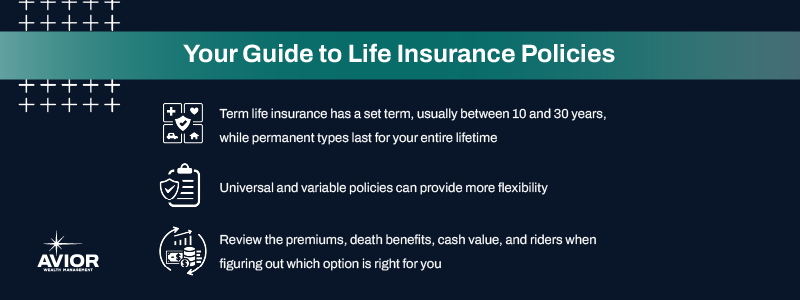Your Guide to Life Insurance Policies
Learn the differences between term, whole, universal, and variable life insurance to choose the right option for your financial plan.

When you’re estate planning and considering your long-term goals, one priority should be insurance. In particular, life insurance provides a safety net for your loved ones in the event of your death. It offers financial protection and peace of mind by ensuring that dependents or beneficiaries receive a lump-sum payment, known as the death benefit when you pass away.
This type of insurance can help you secure the well-being of your spouse, children, or other family members. The benefit can help with funeral costs, outstanding debts, mortgage payments, and daily living expenses. This ensures that loved ones are not burdened with financial hardships during an already challenging time.
With everything in this guide, you’ll have a better understanding of the different types of life insurance policies and where the right option may fit into your financial plan.
Types of life insurance policies
There are several types of life insurance to consider, depending on your financial needs, priorities, and the benefits of each. Here’s a brief overview of the main types:
- Term: Term life insurance has a specified term, unlike permanent life insurance, which is for your whole lifetime. Term coverage is typically for 10, 15, 20, or 30 years. Premiums are typically lower than permanent, but there is no cash value accumulation. This could be a good option for temporary needs, like paying off a mortgage.
- Whole: With whole, you have coverage for your entire lifetime. The benefits are that your premiums are stable and cash accumulates value. This basic type of permanent coverage ensures your beneficiaries receive a death benefit upon your passing.
- Universal: Universal coverage is also a permanent option, but you can have more flexible premiums and still provide a death benefit to loved ones. You can make adjustments to your coverage, so you have flexibility if circumstances change. Universal also provides returns and growth potential with investment options.
- Variable: Similar to mutual funds, with variable coverage, you invest cash value into various sub-accounts. You can allocate premiums among investment options, and you have the potential to see higher returns.
Choosing the right insurance investment depends on your individual circumstances, financial goals, and risk tolerance. For example, term life insurance is the only non-permanent life insurance option, which is best for short-term needs. However, if you want more stability, whole life insurance may be best rather than the more flexible universal or variable. However, those types may provide more opportunities for cash growth.
How to assess your life insurance needs
These different options exist to align with the many priorities that investors may have. When figuring out your life insurance needs, take a look at a few key factors.
Consider your age. Younger investors may have fewer financial obligations and may prioritize coverage for income replacement and debt repayment. Older investors may be thinking about estate planning, final expenses, and legacy preservation.
Identify the number of dependents you have, as this will influence how much coverage you need. In addition, make a list of any outstanding debts, including mortgages or loans, and make sure you factor in these obligations on top of everyday living expenses for your loved ones.
Finally, consider your, and your family’s, long-term goals. Perhaps you want to prioritize funding your beneficiaries’ education, helping them purchase a property, or ensuring your spouse has a comfortable retirement.
Remember that your life insurance needs may change over time. When you or your loved ones go through a major life change or have to deal with a medical condition, you may need to review and adjust your plan accordingly.
Understanding policy terms and benefits
Life insurance policies can be complex and hard to fully grasp. Learning key policy terms will help you compare plans and select the right option. Start with these:
- Premiums: These are the regular payments you make to the insurance company to keep the policy in force. Premiums can vary based on the type of policy and coverage amount. Understanding the premium structure of your policy helps you budget and maintain coverage.
- Death benefits: Death benefits describe what is paid to beneficiaries upon your death. They provide financial support to surviving dependents. Carefully evaluate each policy’s death benefit to secure enough to meet the needs of your loved ones.
- Cash value: This is applicable to permanent life insurance policies. Cash value is the accumulated savings or investment component within the policy. It may be accessed during your lifetime through loans or withdrawals, and understanding the growth potential of each policy helps you make a more informed decision.
- Riders: Riders are additional provisions or options that can be added to a life insurance policy to enhance your coverage based on specific needs. Common riders include accelerated death benefit riders, which allow the policyholder to access a portion of the death benefit in the event of a terminal illness, or waiver of premium riders, which waive premium payments if you become disabled.
Examine each of these details when selecting a policy that aligns with your personal goals and family needs. Also consider the potential for cash-value growth and your investment options with certain life insurance policies.
Choosing the right policy with a financial advisor
Life insurance is a worthy investment avenue to give you peace of mind and your loved ones financial security once you’re gone. Understanding your options and making an informed selection will ensure you’re on track to meet your goals.
One of the best steps you can take when looking at life insurance is talking to a financial advisor. The Avior team can help you assemble your estate plan, including a tailored life insurance policy.
Get in touch with Avior to talk to a wealth management expert today.
Disclaimer: Nothing contained herein should be construed as legal or tax advice. Avior and our Advisors will work with your attorney and/or tax professional to assist with your legal and tax strategies. Please consult your attorney or tax professional with specific legal and/or tax questions. Investment Management and Financial Planner are offered through Avior Wealth Management, LLC, an SEC-registered investment advisor. Past performance is not a guarantee of future results. Investments are subject to loss, including the loss of principal.
No Comments
Sorry, the comment form is closed at this time.




